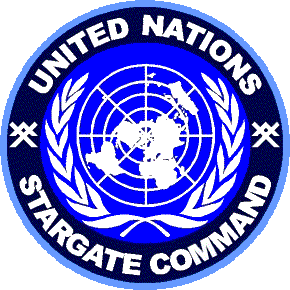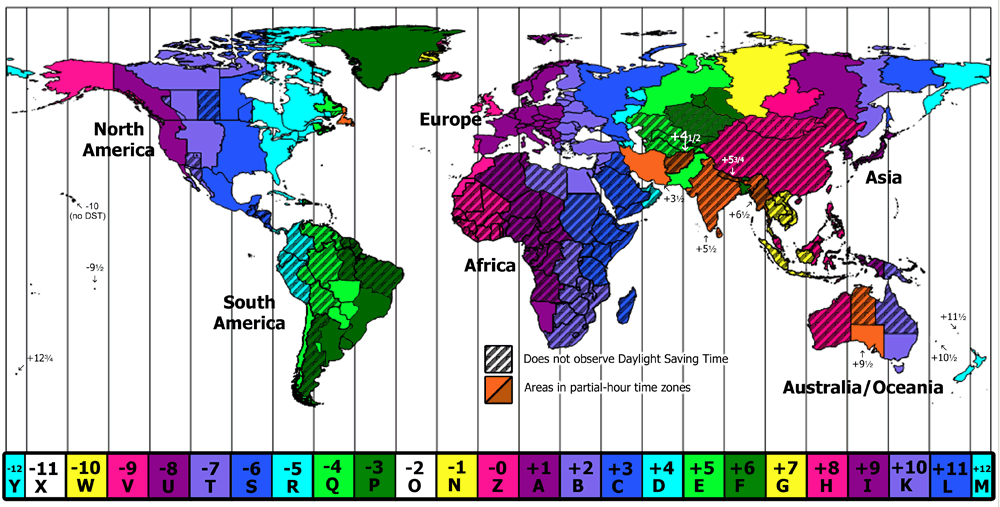| UNRESTRICTED |
|---|
|
15 MAR 17
|

|
Military Time & The DTG Date-Time-Group |

| |||||||
|---|---|---|---|---|---|---|---|---|---|---|

Map of the world showing the time zones, their relationship to ZULU or UTC time (aka GMT) and the assigned letters as used in a DTG.
IntroductionLet us convert a civilian expression of date and time: "a quarter to two, on the afternoon of the 11th of February 2014", to a correct military DTG. What we get can be written depending upon available space as either: As a civilian expression:1.45pm 11th February 2014 Or as an easy to read Date Time Group: 11 1345Z FEB 14 Or as a compact DTG: 111345ZFEB14 < Okay, so let's break it all down for you... Expressing Just The DateIf you want to express a range of dates like those for a CONTACT operation, then a hyphon is placed between the two day dates within a month, for example 16-18 JUN 17 meaning the 16th to 18th of June 2017. If the date of the operation spans the end and the beginning of two months, then you would write: 30 JUN - 02 JUL 16, meaning from the 30th of June to the 2nd of July 2016. You can of course write them out in full with a hyphon between each as 30 JUN 16 - 02 JUL 16 or 30JUN16-02JUL16. This would be necessary when either the date range spans the end and beginning of a year, or if you wanted to incorporate a time element, which will be explained below. The twelve months of the year are therefore written as below left:
Expressions of TimeIt goes through until "2359", or one minute to midnight, said as "twenty three, fifty nine hours". Note that a colon is never inserted between the hours and the minutes digits, as sometimes seen elsewhere. A quarter to two in the afternoon is therefore "1345", or "thirteen forty five hours". See below for a conversion table for the hours of the day.
Time ZonesSo back to our example; having written the time, 1345, the appropriate letter is then appended to the time figures. For us here in the uk, that means during the summer months when we are in British Summer Time or BST (see footnotes), the suffix letter is "A" (ALPHA), so we would get 1345A. Whereas in the winter months when we are in Greenwich Mean Time (GMT), the suffix letter is "Z" (ZULU). So as "FEB" places us in the ZULU Time Zone, our example now reads "1345Z", which would be said as "thirteen forty five zulu". As indicated above in speech this letter is sometimes omitted when everyone is working in the same zone. However if you are in communications with someone in or from a different zone., or if you need to make it absolutely clear that you are expressing a time, and when writing it down, it is always included. When a Time Zone letter is used, the word "hours" is often dropped. See the NATO Phonetic Code to read how to express the letters. The letter "J" (JULIET) is used to mean local time, but for this to mean anything when reading a report it must be absolutely clear to when and where in the world this report is refering. In global level operations, it is common practise to use "ZULU TIME", as a default central reference. This can of course mean, that if you are on the other side of the planet, at sunrise, you may well be noting the time as "1800Z". This is why military chronographs have additional indicators, so that both local and global time is readily available to an operator. One final essential point to be aware of in global operations, is that the International Dateline is NOT straight, it wobbles across several Time Zones as it wends it's merry way up and down the planet. Putting The Date Time Group TogetherWhen it is clear from the context of a document, what month and year you are in, it is normal to write an abridged version of the DTG, as just "11 1345Z" or "111345Z". This can be articulated as "eleven thirteen forty five zulu". This truncated format makes it absolutely clear to which day this time belongs, which in multi day operations is a vital asset. So why this format. In part it is historical, and secondly it has to do with how military operations are planned and executed. The time element is regarded as a sub-set of the day, and so in operations that span several days, having the day date in front, means that when sorting the various parts of a plan out, all those that belong to one day, start with the same number. The month and year are rarely required on the short time scales of most tactical work and so can be omitted for ease of use. This is true, unless of course your plan spans the end and beginning of a month or a year, or it’s a long campaign, like ours, and retention of long term historical records are vital to its future success. By way of an example, the sequence of events for a fictional operation might run like this:
Note the way the Time Zone letter changes in line with daylight savings, which means this was possibly a UK based operation. Also note how the numbers change over the midnight slot, which hopefully makes it clear why the day date especially, is incorporated like this. Finally, it should be clear to you that this represents a historical operation, which was conducted in 1972, and not an upcoming one scheduled for 2072. This is because this format can only span 100 years, and UNSGC campaign records date back to 1946. So our effective cut off date is 2046, after which the UNSGC will need at some point to decide on how to incorporate the milllennium factor. They, along with NATO may eventually decide to adopt a variation of ISO8601, adapted to the special needs of the military, rendering our example as possibly: "2014-02-11T13:45:00.0Z". But I imagine probably not for quite some time yet. If in the meantime you have any questions or suggestions please contact your CO using the UNSGC Central Communications email ling Footnotes & Links to WikiBST (British Summer Time) aka ALPHA Time.GMT (Greenwich Mean Time) aka ZULU Time. UTC is the compromise abbreviation for Coordinated Universal Time and Temps universel coordonné, see the Wiki page.
|
| Top |
|---|
End of Page